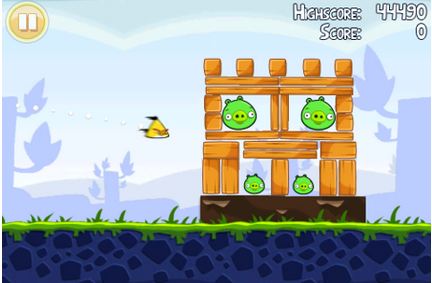Most operations research competitions look at problems that are, frankly, dull. At least to the non-OR-connoisseur. Whether it is optimizing computer usage, nurse scheduling, financial portfolio creation, or rescheduling airplanes, there is a certain utilitarianism about operations research competitions. There are some competitions that have some level of charm (predicting murders in Philadelphia perhaps). But, to the outsider, most of competitions sound as exciting as eating one’s vegetables. Good to do, but rarely filled with anticipation.
I note that our colleagues in artificial intelligence and planning have addressed this issue straight on by developing the Angry Birds Challenge. If you do not know the Angry Birds game, get yourself down to the airport, sit next to any waiting business person with a tablet, and watch what they are doing: chances are they are playing Angry Birds. Or ask any eight year old.
With more than a billion downloads, Angry Birds is one of the world’s leading wasters of computer cycles. The game is popular enough that my wife and I went as game characters last Halloween, as you can see.
To summarize, your goal in Angry Birds is to slingshot birds towards various structures in an attempt to kill pigs lurking within (really!). Your birds have different capabilities (some might drop bombs, others can split into multiple birds), and it is necessary to use those capabilities to get to all the pigs.
 The game is not as mindless as it might appear. The underlying physics engine is very good, so the collapse of the structures when hit by the birds generally feels right. Killing the pigs takes foresight, planning, creativity (of a very specialized kind), and sometimes a little luck. So, a natural question is: can you create a computer system to play angry birds?
The game is not as mindless as it might appear. The underlying physics engine is very good, so the collapse of the structures when hit by the birds generally feels right. Killing the pigs takes foresight, planning, creativity (of a very specialized kind), and sometimes a little luck. So, a natural question is: can you create a computer system to play angry birds?
For some human time-wasters, computer systems are very easy to create. It is straightforward to create a sudoku-solver far better than any human. For Angry Birds, it is not so clear. There is no obvious brute-force search that has a hope of leading to a solution. Even the problem representation seems to be a difficult issue. This looks to be quite a challenging problem!
I don’t see how to use traditional operations research methods for this problem. But it would be great if we could show that operations research is awesome enough to solve the big problem of our time: how to get three stars on level 4-14!